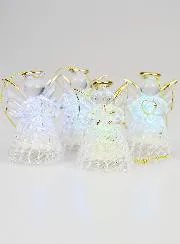Why is Christmas celebrated on 25 December?
The celebration of Christmas on 25 December is one of the most deeply rooted traditions in Christianity. Yet this precise date is not mentioned in the Scriptures. Its origins are the result of centuries of evolution, combining religious traditions, cultural influences and theological symbolism. This article explores in depth the reasons that led to Christmas being fixed on 25 December and what this date means for Christians today.
The birth of Jesus: an undated mystery in the Gospels
The Gospels, the main texts recounting the life of Jesus Christ, give no details of the exact date of his birth. The accounts of Matthew and Luke, the only ones to deal with the Nativity, focus more on the context and significance of the event:
Matthew highlights the coming of the Magi guided by a star.
Luke mentions the angels announcing the Saviour's birth to the shepherds.
No indication of day, month or even season is given. Certain contextual clues, such as the presence of the shepherds in the fields, suggest that Jesus could have been born in a milder period, such as spring. However, these hypotheses remain uncertain.
So why 25 December? This question finds its answers in historical and symbolic considerations.
The influences of pagan festivities around the winter solstice
One widely accepted theory is that the choice of 25 December was inspired by pagan festivities that were already well established at this time. In the Roman Empire, several celebrations marked the winter solstice, the moment when the days begin to lengthen after the longest night of the year:
The Saturnalia: Celebrated in honour of Saturn, god of agriculture, these festivals lasted several days and were marked by revelry, gift exchanges and an atmosphere of social role reversal.
The Dies Natalis Solis Invicti: This festival, instituted by the emperor Aurelian in 274, honoured the "unconquered Sun". It symbolised the gradual return of light after the winter darkness.
These festivities were very popular, and it is likely that the Christian Church chose this period to establish Christmas, in order to divert these pagan rites towards a Christian celebration. Jesus, often called the "light of the world" (John 8:12), was presented as a spiritual alternative to Sun worship.
The theology behind 25 December
The choice of 25 December is not based solely on practical or historical considerations. It also has a strong theological dimension.
Light in the darkness: A conception on 25 March
The winter solstice marks a turning point: the days grow longer, symbolising the victory of light over darkness. This symbolism is central to the Christian faith, where Jesus is seen as the light that has come to dispel the darkness of sin and death.
An ancient tradition, stemming from Christian thought, holds that Jesus was conceived at the Annunciation, on 25 March. Nine months later, this would lead to a birth on 25 December. This association between conception and birth reflects a vision of divine harmony and underlines the importance of the Incarnation in the plan of salvation.
The officialisation of Christmas on 25 December
The influence of Emperor Constantine and the role of the Church.
In the 4th century, Emperor Constantine, the first Roman emperor to convert to Christianity, played a decisive role in unifying Christian practices. In 313, he promulgated the Edict of Milan, putting an end to the persecution of Christians. Constantine sought to incorporate Christmas into the official calendar of religious festivals, probably to consolidate the position of Christianity in the Empire. Pope Julius I, in the middle of the fourth century, is said to have formally fixed Christmas on 25 December. This decision was intended to establish a common festival for all Christians, while offering a Christian alternative to the pagan celebrations still present.
From then on, Christmas became an official liturgical festival, celebrated with masses and rites reminiscent of the Nativity.
The diversity of Christmas traditions
Over time, Christmas has incorporated a variety of cultural elements, sometimes derived from the pagan traditions it had initially sought to replace. For example:
Nativity scenes: Introduced by St Francis of Assisi in the 13th century, they recall the biblical story and make the Nativity more tangible.
The gifts: Inspired by Saturnalia and the visit of the Magi, they symbolise God's ultimate gift to humanity in Jesus.
Lights and decorations: These evoke the victory of divine light over darkness.
Christmas: A celebration beyond the date
For Christians, the meaning of Christmas goes beyond the simple choice of a date. This day is a celebration of the Incarnation, when God became man to bring redemption. It is an invitation to meditate on the mystery of divine love and to renew our faith. The rites and traditions associated with Christmas, such as midnight mass, carols and family gatherings, bear witness to the importance of this festival in transmitting the values of hope, peace and charity.
The choice of 25 December to celebrate Christmas is the result of a convergence of religious, historical and theological traditions. While this date has been influenced by cultural contexts, its profound meaning remains unchanged for Christians: the coming of Jesus Christ, the light of the world and Saviour of mankind. Christmas is much more than just a date. It is a time of joy, reflection and spiritual renewal, when believers are called to welcome into their hearts the One who has come to illuminate their lives. May this feast be for everyone an opportunity to celebrate this immeasurable love and to share peace and light around us.




















